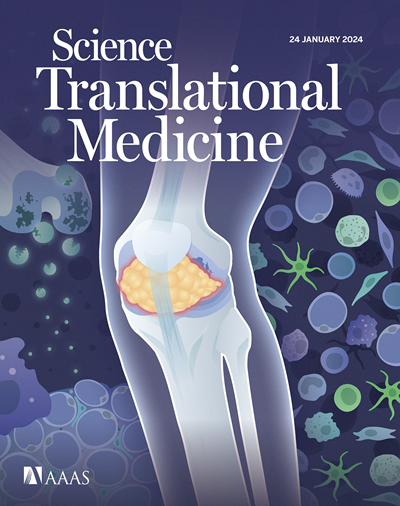一种与胃肠道经鼻内窥镜兼容的薄冷冻活检装置
IF 15.8
1区 医学
Q1 CELL BIOLOGY
引用次数: 0
摘要
腔内器官活检是疾病诊断的关键,通过大型内窥镜的工作通道插入单咬钳获得。使用这些内窥镜的手术通常需要患者镇静或麻醉,可能不适用于儿科患者。此外,钳源性活检可能难以维持组织定向、挤压伪影以及缺乏对活检深度的精确控制。麻醉和镇静的高成本和风险推动了小型内窥镜的发展,用于非镇静手术。然而,缩小的内窥镜尺寸限制了工作通道的尺寸,将活检钳限制在可能产生不足或非诊断样本的尺寸上。为了解决这些限制,我们开发了一种图像引导,深度控制,超小直径(1.2毫米)低温活检装置(μCryoProbe)。我们优化了进入设备的冷却剂流型以增强组织冷冻,优化了设备与组织的接触时间和冷冻深度。我们在离体临床前组织、体内猪模型和镇静的人类参与者中测试了该设备的胃肠道活检收集。将食道、胃和十二指肠粘膜冷冻活检的尺寸和质量与钳源性活检进行比较,发现μCryoProbe设备始终如一地产生高质量的活检,组织定向最佳,无挤压伪影。我们还展示了从镇静的人类参与者身上捕获胃肠道活检的能力。通过使用小直径活检工具捕获大的、定向良好的样本,该技术有可能将程序从大内窥镜转移到小内窥镜,减少对镇静的需求,并通过获取质量更好的组织样本来提高患者的诊断。本文章由计算机程序翻译,如有差异,请以英文原文为准。
A thin cryobiopsy device compatible with transnasal endoscopy for the gastrointestinal tract
Luminal organ biopsies are critical for disease diagnosis and are obtained using single-bite forceps inserted through the working channel of large endoscopes. Procedures using these endoscopes frequently require patient sedation or anesthesia and may not be feasible for use in pediatric patients. Additionally, forceps-derived biopsies can suffer from difficulty maintaining tissue orientation, crush artifacts, and lack of precise control of biopsy depth. The high cost and risks of anesthesia and sedation have driven the development of smaller endoscopes for unsedated procedures. However, reduced endoscope size limits working-channel dimensions, restricting biopsy forceps to sizes that may yield insufficient or nondiagnostic samples. To address these limitations, we developed an image-guided, depth-controlled, ultrasmall-diameter (1.2-millimeters) cryobiopsy device (μCryoProbe). We optimized the coolant flow profile into the device to enhance tissue freezing, optimizing device-tissue contact time and freezing depth. We tested the device for gastrointestinal biopsy collection in ex vivo preclinical tissues, in an in vivo porcine model, and in sedated human participants. Dimensions and quality of mucosal cryobiopsies from esophagus, stomach, and duodenum were compared with those of forceps-derived biopsies, and it was found that the μCryoProbe device consistently produced high-quality biopsies with optimal tissue orientation and no evidence of crush artifacts. We also demonstrated the ability to capture gastrointestinal biopsies from sedated human participants. By capturing large, well-oriented samples using a small-diameter biopsy tool, this technology has the potential to shift procedures from large to small endoscopes, reducing the need for sedation and improving patient diagnosis through the acquisition of tissue samples with better quality.
求助全文
通过发布文献求助,成功后即可免费获取论文全文。
去求助
来源期刊

Science Translational Medicine
CELL BIOLOGY-MEDICINE, RESEARCH & EXPERIMENTAL
CiteScore
26.70
自引率
1.20%
发文量
309
审稿时长
1.7 months
期刊介绍:
Science Translational Medicine is an online journal that focuses on publishing research at the intersection of science, engineering, and medicine. The goal of the journal is to promote human health by providing a platform for researchers from various disciplines to communicate their latest advancements in biomedical, translational, and clinical research.
The journal aims to address the slow translation of scientific knowledge into effective treatments and health measures. It publishes articles that fill the knowledge gaps between preclinical research and medical applications, with a focus on accelerating the translation of knowledge into new ways of preventing, diagnosing, and treating human diseases.
The scope of Science Translational Medicine includes various areas such as cardiovascular disease, immunology/vaccines, metabolism/diabetes/obesity, neuroscience/neurology/psychiatry, cancer, infectious diseases, policy, behavior, bioengineering, chemical genomics/drug discovery, imaging, applied physical sciences, medical nanotechnology, drug delivery, biomarkers, gene therapy/regenerative medicine, toxicology and pharmacokinetics, data mining, cell culture, animal and human studies, medical informatics, and other interdisciplinary approaches to medicine.
The target audience of the journal includes researchers and management in academia, government, and the biotechnology and pharmaceutical industries. It is also relevant to physician scientists, regulators, policy makers, investors, business developers, and funding agencies.
 求助内容:
求助内容: 应助结果提醒方式:
应助结果提醒方式:


